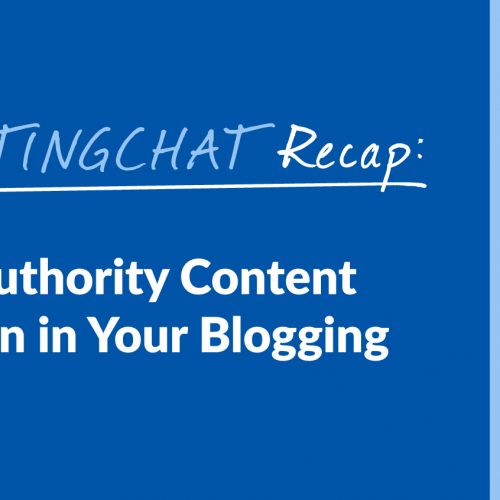#ContentWritingChat Recap: How to Create Authority Content for Serious Return in Your Blogging with Julia McCoy
Are you wondering how to create authority content for your blog to see major results online? This week’s #ContentWritingChat is especially for you! Our chat participants shared some amazing advice that will have you creating high-quality content in no time at all. #ContentWritingChat Recap: How to Create Authority Content for Serious Return in Your Blogging with Julia McCoy Welcome to #ContentWritingChat! Today, @JuliaEMcCoy is guest hosting to talk about authoritative content! ? Who is ready to chat?! pic.twitter.com/ddWN2fk00b — Express Writers (@ExpWriters) August 15, 2017 Our CEO, Julia McCoy, joined in as a guest host for this week’s chat. Considering she provides valuable content on our own blog and for other websites, she’s a great person to teach all of us how to create authority content. Now, let’s dive into the recap! Q1: 2 million blogs go out daily. How can you create content that positions you as an authority in your field online? There are obviously a lot of blog posts being published on a daily basis. This makes it hard to stand out online, but it can be done if you position yourself as an authority. How do you do that? Check out this advice from the chat: A1 Have something to say that matters. 1) Know your audience 2) Write to be read 3) Be consistent with showing up. #ContentWritingChat pic.twitter.com/hAIVhxyyWM — Julia McCoy ? (@JuliaEMcCoy) August 15, 2017 Julia’s advice is to have something to say that actually matters. She says you need to know your audience, write to be read, and be consistent by always showing up. A1: Know your audience so you can connect with them. By doing so, your audience will trust you, which builds authority. #contentwritingchat — Netvantage Marketing (@netvantage) August 15, 2017 Lexie’s advice is to make sure you know your audience so you can truly connect with them. This is going to help you build trust, therefore establishing you as an authority with your targeted audience members. A1a: Provide practical/actionable solutions to challenges your target audience needs help addressing. #ContentWritingChat — Javier Sanabria (@SanabriaJav) August 15, 2017 When you provide practical, actionable advice that addresses the needs of your audience, they’ll appreciate you for it. When they see that you can solve their problems, it starts to build your authority and keeps them coming back for more. A1: Using data & citing reliable sources to back up whatever it is you are saying are great ways to establish authority. #ContentWritingChat — Simply Measured (@simplymeasured) August 15, 2017 Don’t forget that you need to use data and cite sources to back up the points you make. You don’t want anyone questioning whether or not your content is reliable. A1. Try not to focus on all those other blogs. Do your thing and do it better than anybody else. #ContentWritingChat — YourWebContentWriter (@WebContent4U) August 15, 2017 Focus on YOU. You should always strive to do your best when you create authority content. A1 #funfact Authority is only given to those who earn it. Dedication to your audience and to good writing is key. #contentwritingchat pic.twitter.com/cE76cBc2qq — HeyOrca! (@HeyOrca) August 15, 2017 If you want to be an authority, you have to earn it. Kristen said you need to be dedicated to your audience and to quality writing. Q2: Discuss how to find and reach your audience personally to create authoritative content at is of specific value to them. Are you wondering how to find and reach your audience when creating content online? Here’s what you need to know: A2a New audience discovery: research your market w/ Facebook Audience Insights & Google surveys #ContentWritingChat — Julia McCoy ? (@JuliaEMcCoy) August 15, 2017 A2b Existing audience discovery: survey your list with a form that asks them questions. Call a few clients up. #ContentWritingChat — Julia McCoy ? (@JuliaEMcCoy) August 15, 2017 Julia shared some great tips for getting to know your audience. She suggested researching your market with Facebook Audience Insights and Google surveys. For your existing audience, you can email your list a survey that asks questions you want answers to. Then, hop on the phone with a few clients and have a chat. A2: This is where #sociallistening comes into play. To provide value, you have to know what your audience needs. #ContentWritingChat — Simply Measured (@simplymeasured) August 15, 2017 Social listening is a great way to essentially eavesdrop on your audience. Figure out which platforms they spend the most time on and locate them. Pay attention to what they’re posting and talking about. A2. Most of the time, I find my audience through Twitter chats because this platform is so cool #contentwritingchat — Cheval John (@chevd80) August 15, 2017 A great way to perform social listening is through Twitter chats. Cheval knows how beneficial they are when it comes to finding your target audience. A2: Visit online forums/chats where the audience discusses their challenges; craft content around those conversations. #ContentWritingChat — Javier Sanabria (@SanabriaJav) August 15, 2017 Javier suggests checking out some online forums and chats where your audience is hanging out. Be present on those platforms by engaging with your audience. Figure out what they’re struggling with and you can create content that solves their problems. A2: Explore/ join Facebook Groups. Discover your audience + their FAQs. Create content based on those questions. #ContentWritingChat pic.twitter.com/5ZGVXO0dq3 — Beth Farris (@bethbabble) August 15, 2017 Facebook Groups are a great place to hang out! You just need to find the ones your audience spends their time in. Then, pay attention to what they’re saying! A2: Look at your data and then ask ?’s. We need to stop assuming and start listening to our audience. #ContentWritingChat pic.twitter.com/sQuwvLljhW — Seth Waite (@Seth_Waite) August 15, 2017 As Seth pointed out, we can also learn a lot about our audience from the data we’ve already obtained. Check out your Google Analytics to learn more about who your audience is and what they’re interested in, for example. Q3: What is one of the top authority content formats … Read more


